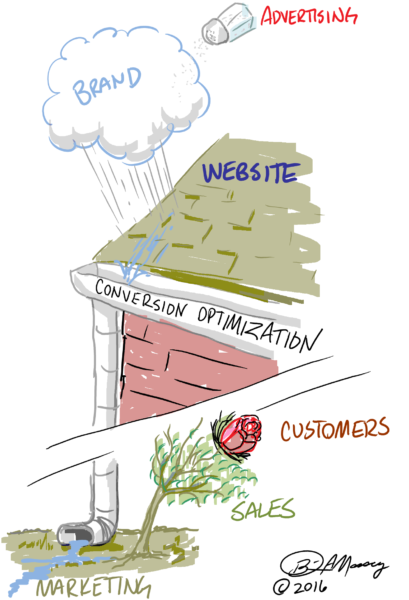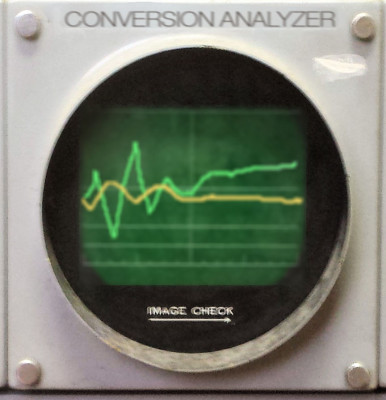Visualizing Your Marketing And Sales Process
Columnist Brian Massey explains why using a metaphor to help you visualize all the pieces of your "marketing machine" can help you zero in on each part and make powerful decisions.

When you think of the machine that is your online business, what do you picture? Do you see something organic? Something mechanical?
I think it’s helpful to pick a vision. The marketing and sales functions are too complex. The tools and channels are changing faster today than at any time in history. Thanks, internet.

Vizualize your marketing machine to make good decisions about where to invest.
Visualizing the process helps us focus on the pieces one at a time, instead of being overwhelmed by the mass of moving parts that feed our pipes, funnels and drips. When we work with clients, we tend to talk about knobs.
Here’s what I mean.
Our Marketing Machine Looks Like A Scientific Instrument
The most powerful metric for an online marketing ecosystem is acquisition cost.
The lower your acquisition cost, the higher your profit.
The lower your acquisition cost, the cheaper all of your advertising becomes.
The lower your acquisition cost, the more places you can afford to advertise.
But acquisition cost isn’t a dial you set. It’s the product of several dials.
The Acquisition Cost Spectrophotometer
We control acquisition costs using a device called the “Acquisition Cost Spectrophotometer” (ACS). This powerful device has two dials.
1. Traffic cost
2. Conversions — Typically leads or online transactions
We plug the ACS into any incoming channel — search engines, email, referrals, social media and so on. Then we begin to play with the knobs.
If we increase the traffic costs, but the conversions stay the same, we increase our acquisition cost, and the little red warning light turns on. If we dial down the traffic costs and keep the conversions the same, acquisition costs go down, and the red warning light goes off.
If we can increase conversions without increasing traffic costs, we get all the benefits of a lower acquisition cost. And for the paid search channel, we can actually lower the traffic costs by raising the conversion rate because Google rewards ads with effective landing pages by placing them higher on the search results pages.
Mathematically, the acquisition cost is calculated as:
Total Traffic Cost/Conversions
OR
Total Traffic Cost * Conversion Rate
If we put our metaphor down for a moment, we know that each of these “knobs” actually involves an entire process. Our “Traffic Cost” knob is controlled by an advertising and media team focused on getting the highest quality clicks for the fewest dollars.
Our “Conversions” knob is a metaphor for a team of data scientists, developers, designers and test techs focused on delivering the right experience to entice action.
All the marketer needs to do is determine if they should be investing in traffic or conversions, then fund the teams accordingly.
Vectron Conversion Analyzer

We visualize knobs on the Vectron Conversion Analyzer when optimizing a site.
When focused on optimizing a website for a given traffic channel, there are a number of knobs we control. I visualize a “Vectron Conversion Analyzer” as a metaphor for our process.
This amazing device allows us to control a number of “ingredients” that can lead to more conversions for any given traffic source. If you read this column, you’ll be familiar with most of the knobs on this little gem.
Value Proposition
The headlines, text and images that spell out the value being offered by your company and products. Answers the question, “What’s in it for me?”
Layout and User Experience
The way the design draws a visitor’s eye to the important parts of each page and the cues that move them step-by-step along their exploratory journey.
Should important information be moved above the fold? Is there a visual hierarchy that tells the visitor what is important?
Credibility And Authority
A site design’s first job is to make the site seem credible. It should communicate that the company and products represent an authority in the solution space that it occupies.
Trust And Security
The visual cues that tell a visitor that the site will treat any information exchanged with care and veracity.
Social Proof
What do others like me think about this company, site and products?
Splitting The Signal
The Vectron machine splits the traffic up, allowing us to test different settings at one time. This is how we determine two very important things:
1. What is lacking from the site that visitors expect.
2. By how much each change increases the site’s performance.

Visualizations That Help You Prioritize
We rarely have the budgets to invest in every part of our marketing machine. Having a metaphor by which you can visualize the pieces working together offers a powerful way to decide how to invest over time.
Using the visualization at the top of this page, you may not have any luck seeding your brand clouds with advertising until you’ve built brand awareness. When it rains, you should invest in the downspouts that drive leads into the soil of marketing.
If your sales close ratios aren’t flowering, you may need to look at the quality delivered by ads and conversion together. Once you have a low acquisition cost, you can again invest in more expensive advertising channels to seed your brand’s rain clouds and bring the rain.
What metaphor do you use for your marketing machine? Draw it for us and share a link on Facebook, Twitter or our LinkedIn Group.
Contributing authors are invited to create content for MarTech and are chosen for their expertise and contribution to the martech community. Our contributors work under the oversight of the editorial staff and contributions are checked for quality and relevance to our readers. MarTech is owned by Semrush. Contributor was not asked to make any direct or indirect mentions of Semrush. The opinions they express are their own.
Related stories
New on MarTech